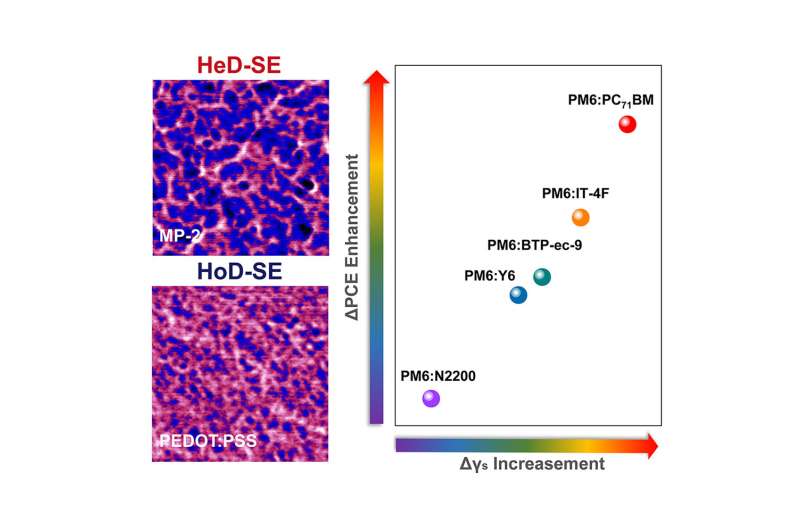Researchers propose new strategy for interfacial modification of organic solar cells

Surface energy (γs) plays a key role in the formation of bulk-heterojunction (BHJ) films in organic solar cells fabricated by solution process. The miscibility of BHJ films can be predicted by the difference of surface energy between donor and acceptor. The vertical distribution and the stacking orientation of BHJ films can be regulated by the surface energy in the bottom interface layer. The surface energy of thin film is usually obtained by measuring contact angle using Owens-Wendt model.
However, this measurement method cannot reflect the surface energy distribution in the nanoscale range, and it cannot directly explain the nanoscale stacking and phase separation in the BHJ structure.
Recently, a research team led by Profs. Zhou Huiqiong, Qiu Xiaohui and Zhang Yong from the National Center for Nanoscience and Technology (NCNST) of the Chinese Academy of Sciences (CAS) proposed a new strategy to investigate the regulation of nanoscale surface energy distribution at the interface layer of organic solar cells. The study was published in Joule.
The researchers used the AFM-based Peak-Force Quantitative Nanomechanical Mappings (PFQNM) technique to characterize the nanoscale surface energy distribution of hole transporting layers in organic solar cells. They found that the surface energy distribution of poly3, 4-ethylenedioxythiophene: polystyrene sulfonate (PEDOT:PSS) can be effectively regulated by doping MoS2 nanosheets with different lateral sizes and the heterogeneity of PEDOT:PSS distribution can be enlarged. The heterogeneous distribution of surface energy (HeD-SE) can further regulate the molecular distribution, crystal orientation and phase separation of the active layer.
Due to the optimization of the active layer morphology by the HeD-SE, the performance and stability of organic solar cells were enhanced with the best power conversion efficiency (PCE) of 18.27%. Besides, the enhancement ratio of PCE was proportional to the enlargement of Δγs in the BHJ.
Prof. Zhou's team has been devoted to the interface manipulation in solution-processed organic solar cells, and has carried out a series of studies on the surface energy regulation in organic solar cells. The researchers first achieved a high fill factor of 80% in organic solar cell by incorporating WOx nanoparticles in PEDOT:PSS. Then they explored the relationships between the stacking orientation of the active layer, the performance of organic solar cells and the surface energy of the interface layer. The strategy of interfacial modification was used to study electron transporting layer in inverted devices, and has been utilized in perovskite solar cells. By using the biopolymer heparin sodium to modify the surface energy, the interface defect of perovskite solar cells was passivated with improvements of PCE and stability.
More information: Yanxun Li et al, Nanoscale heterogeneous distribution of surface energy at interlayers in organic bulk-heterojunction solar cells, Joule (2021). DOI: 10.1016/j.joule.2021.09.001
Journal information: Joule
Provided by Chinese Academy of Sciences





















